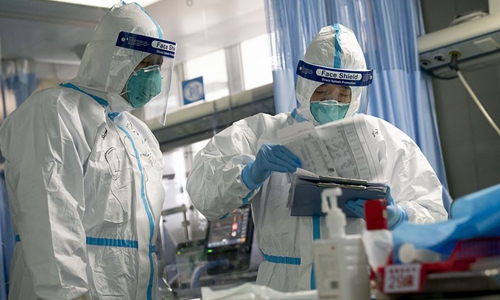HOME >> CHINA
Wuhan pathogen biologist addresses six conundrums about deadly novel coronavirus
By GT staff reporters Source:Global Times Published: 2020/2/16 20:08:40

A medical worker checks diagnosis record of a patient with his colleague in Zhongnan Hospital of Wuhan University in Wuhan, central China's Hubei Province, Jan. 24, 2020. Photo:Xinhua
No final conclusion on the natural host of the COVID-19 virus has been made yet so far, which is key to epidemic prevention as an unclear origin means there is a potential risk of animal-to-human infection, a top Wuhan pathogen biologist told the Global Times in an exclusive interview.Despite that some positive signs emerge from the ongoing COVID-19 outbreak as the ratio of critical patients to all confirmed cases has declined across China including the epicenter Wuhan, there are still some key questions about the deadly coronavirus that remain unanswered.
Addressing the six key conundrums surrounding the virus, Yang Zhanqiu, deputy director of the pathogen biology department at Wuhan University, told the Global Times that the conclusion that the virus comes from bats came from the 80 percent similarity between the novel coronavirus and the virus that caused SARS, and the fact that no new evidence has emerged to refute it.
"But in fact, there isn't a final conclusion on the natural host of the virus," Yang said.
Even if bats were the natural host, it is unclear how it was transmitted from bats living in deep forests to human beings.
"Further investigation is necessary even if the novel coronavirus were to be found on live bats. If a bat carrying the virus could infect other animals and the new animal shows symptoms, the transmission channel is clear. If the new animal doesn't get infected or have symptoms, the hypothesis is still untenable," Yang told the Global Times.
Identifying the origin of the virus is critical to epidemic prevention. An unclear origin means there is a potential risk of animal-human infection, Yang said.
The place where the epidemic originated from is also undetermined, although earlier reports have connected the outbreak to the Huanan seafood market in Wuhan.
It is possible that wild animals sold at the market infected human beings. But out of the first 41 confirmed cases, 13 had never been to the market, making the problem even more confusing, Yang said.
There were various wild animals in the market, and while bats were suspected of being the source, bats were not on sale in the market, a question which remains to be addressed, Yang said.
The poor conditions at the seafood market made it an ideal place for the virus to reproduce and spread. But currently, we can only say that "Huanan seafood market is likely to be one of the places of the origin of the epidemic," Yang said.
Regarding the "biochemical war" conspiracy theory circulated online, Yang explained that Wuhan held the Military World Games in October last year and the US delegation stayed in a hotel not far from the seafood market. Wuhan discovered cases of coronavirus infection later in December.
"This is why some people have speculated that the outbreak is a biochemical war conspiracy launched by the US against China," Yang said.
But there was no way to prove it. "The topic is not appropriate to circulate and ferment among the public. I have to say that biochemical war lacks ethics and its possibility is extremely small," he said.
Yang also refuted speculation that the virus was leaked from a lab, saying that it could not have come from the Wuhan Institute of Virology, as it did not have the coronavirus. It was experts of the Chinese Center for Disease Control and Prevention (CDC) isolated the novel coronavirus in the environmental samples of a seafood market in Wuhan with no involvement from the Wuhan Institute of Virology.
Yang told the Global Times the Wuhan Institute of Virology is a biosafety Level 4, lab, and its protective measures are extremely strict.
The institute, located in the east side of Wuhan, is 80 kilometers away from the seafood market, which is in the west of the city. "If the virus was leaked from the Wuhan Institute of Virology, cases should have been discovered near the lab, not the remote seafood market. There is no chance that the coronavirus was leaked from the lab."
The coronavirus' "cunningness" is based on the lack of clarity in its transmission routes. The main transmission channel is through respiratory and contact transmission, while fecal-oral and aerosol transmission is still being studied.
"From the virus itself, different genetic characteristics and different types of viruses have different pathogenicity and infectivity. The biggest threat to the new coronavirus lies in its long incubation period. The cases discovered by the team led by epidemiologist Zhong Nanshan can reach up to 24 days. However, the previous SARS virus infection showed symptoms in about 10-24 hours."
Yang believed that the long incubation period indicates that the coronavirus has a longer process of adapting to the new host, and it is only when this happens that the latter will become ill.
Did the virus intentionally hide itself? According to Yang, the virus is less capable of adapting to new hosts, and therefore it has a longer incubation period. But it then poses a major threat: a large number of infections without symptoms during the incubation period.
In addition, from the perspective of genetic classification, the coronavirus evolves fast, which indicates that this virus can adapt to various environments, Yang noted.
After a new virus is discovered, drugs that can kill or inhibit its reproduction can be developed, but this requires time, Yang said, noting that all antiviral drugs share one characteristic: they have an effect on the virus, but they also have toxic effects that cause damage to the human body.
"As all antiviral drugs have a toxic effect, the treatment is a trade-off between its toxicity and the virus' threat to human health," Yang said.
Posted in: SOCIETY